6-2 A reflecting telescope uses a mirror to concentrate incoming light at a focus
Almost all modern telescopes form an image using the principle of reflection. To understand reflection, imagine drawing a dashed line perpendicular to the surface of a flat mirror at the point where a light ray strikes the mirror (Figure 6-9a). The angle i between the incident (arriving) light ray and the perpendicular is always equal to the angle r between the reflected ray and the perpendicular.
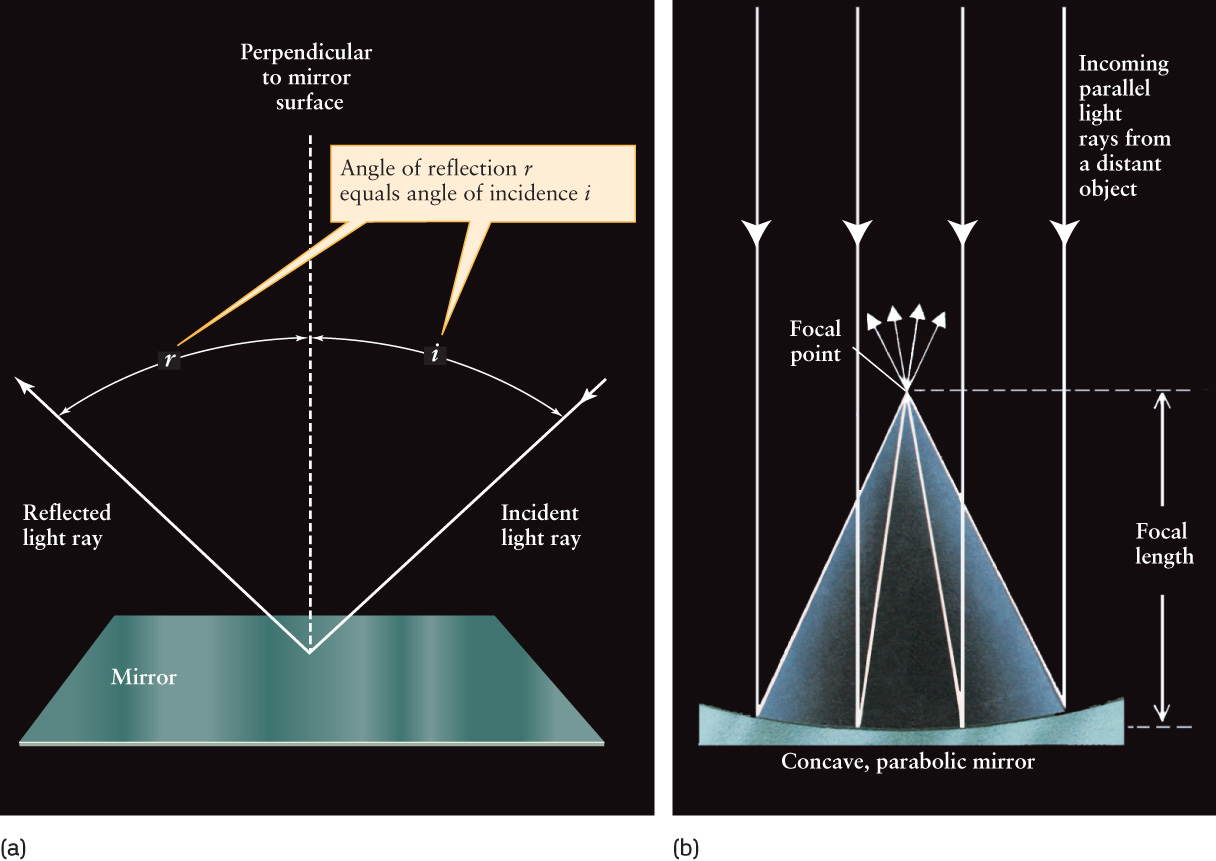
All of the largest professional telescopes—and most amateur telescopes—are reflecting telescopes
In 1663, the Scottish mathematician James Gregory first proposed a telescope using reflection from a concave mirror—one that is fatter at the edges than at the middle. Such a mirror makes parallel light rays converge to a focus (Figure 6-9b). The distance between the reflecting surface and the focus is the focal length of the mirror. A telescope that uses a curved mirror to make an image of a distant object is called a reflecting telescope, or reflector. Using terminology similar to that used for refractors, the mirror that forms the image is called the objective mirror or primary mirror.
To make a reflector mirror, an optician grinds and polishes a large slab of glass into the appropriate concave shape. The glass is then coated with silver, aluminum, or a similar highly reflective substance. Because light reflects off the surface of the coated glass rather than passing through it, defects within the glass—which would have very negative consequences for the objective lens of a refracting telescope—have no effect on the optical quality of a reflecting telescope.
Another advantage of reflector mirrors is that they do not suffer from the chromatic aberration that plagues refractors. This is because reflection is not affected by the wavelength of the incoming light (only the angle it hits the mirror), so all wavelengths are reflected to the same focus. (A small amount of chromatic aberration may arise if the image is viewed using an eyepiece lens.) Furthermore, the mirror can be fully supported by braces on its back, so that a large, heavy mirror can be mounted and well-supported without its shape warping much from gravity.
Designs for Reflecting Telescopes
Although a reflecting telescope has many advantages over a refractor, the arrangement shown in Figure 6-9a is not ideal. One problem is that the focal point is in front of the objective mirror. If you try to view the image formed at the focal point, your head will block part or all of the light from reaching the mirror.
To get around this problem, in 1668 Isaac Newton simply placed a small, flat mirror at a 45° angle in front of the focal point, as sketched in Figure 6-10a. This secondary mirror deflects the light rays to one side, where Newton placed an eyepiece lens to magnify the image. A reflecting telescope with this optical design is appropriately called a Newtonian reflector (Figure 6-10b). The magnifying power of a Newtonian reflector is calculated in the same way as for a refractor: The focal length of the objective mirror is divided by the focal length of the eyepiece (see Box 6-1).
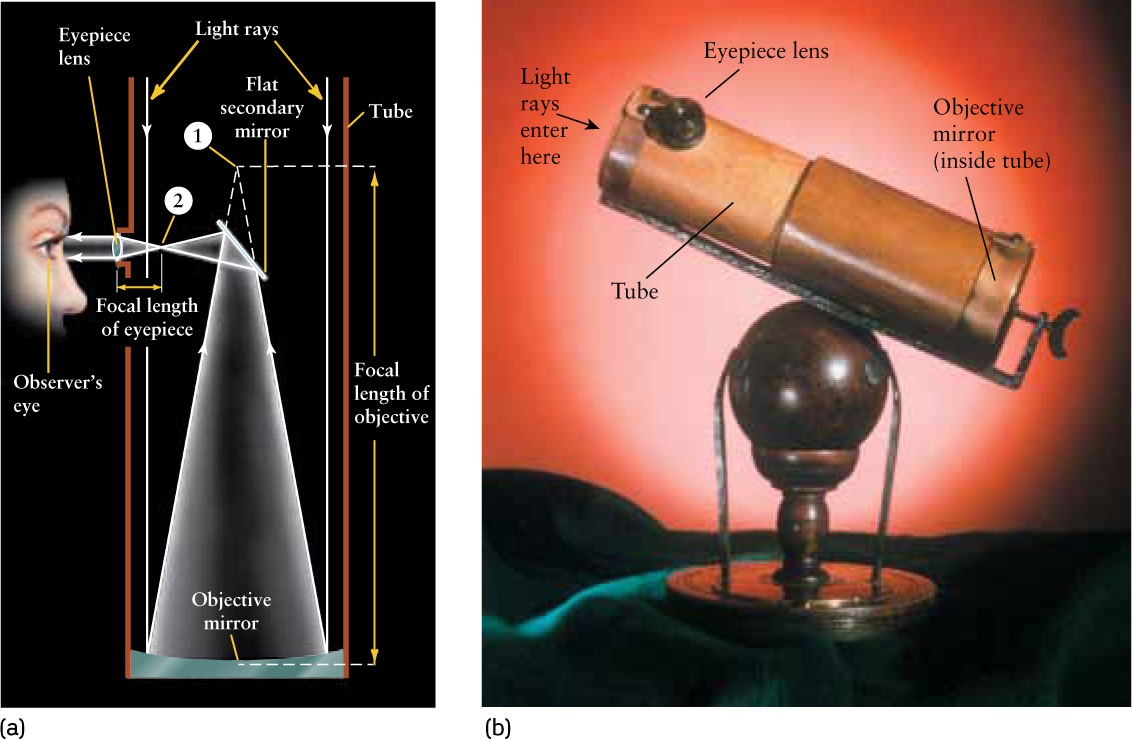
A Newtonian Telescope (a) In a Newtonian telescope, the image made by the objective is moved from point 1 to point 2 by means of a flat mirror called the secondary. An eyepiece magnifies this image, just as for a refracting telescope (Figure 6-5). (b) This is a replica of a Newtonian telescope built by Isaac Newton in 1672. The objective mirror is 3 cm (1.3 inches) in diameter and the magnification is 40✕.
Later astronomers modified Newton’s original design. The objective mirrors of some modern reflectors are so large that an astronomer could actually sit in an “observing cage” at the undeflected focal point directly in front of the objective mirror. (In practice, riding in this cage on a winter’s night is a remarkably cold and uncomfortable experience.) This arrangement is called a prime focus (Figure 6-11a). It usually provides the highest-quality image, because there is no need for a secondary mirror (which might have imperfections).
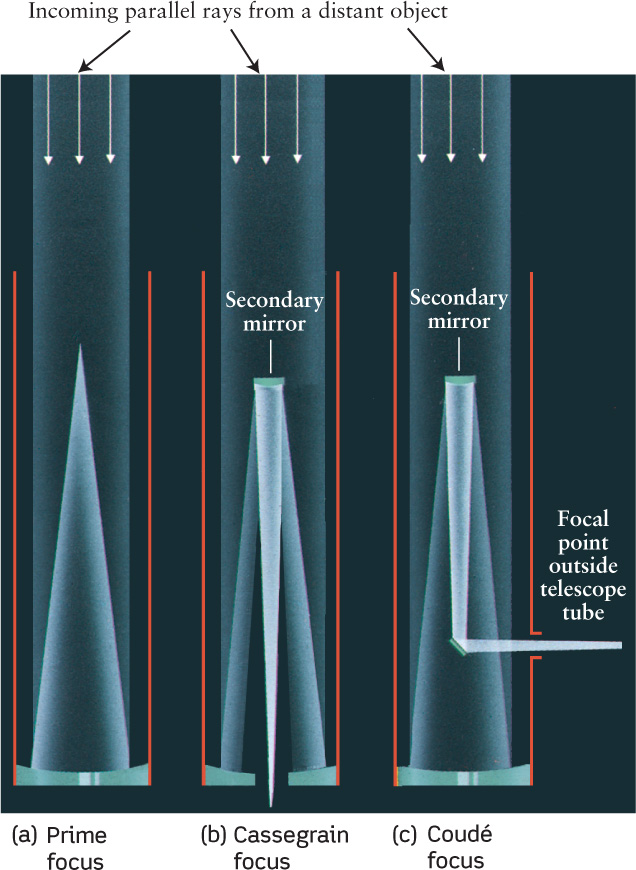
 Designs for Reflecting Telescopes Three common optical designs for reflecting telescopes are shown here. (a) Prime focus is used only on some large telescopes; an observer or instrument is placed directly at the focal point, within the barrel of the telescope. (b) The Cassegrain focus is used on reflecting telescopes of all sizes, from 90-mm (3.5-in.) reflectors used by amateur astronomers to giant research telescopes on Mauna Kea (see Figure 6-14). (c) The coudé focus is useful when large and heavy optical apparatus is to be used at the focal point. Light reflects off the objective mirror to a secondary mirror, then back down to a third, angled mirror. With this arrangement, the heavy apparatus at the focal point does not have to move when the telescope is repositioned.
Designs for Reflecting Telescopes Three common optical designs for reflecting telescopes are shown here. (a) Prime focus is used only on some large telescopes; an observer or instrument is placed directly at the focal point, within the barrel of the telescope. (b) The Cassegrain focus is used on reflecting telescopes of all sizes, from 90-mm (3.5-in.) reflectors used by amateur astronomers to giant research telescopes on Mauna Kea (see Figure 6-14). (c) The coudé focus is useful when large and heavy optical apparatus is to be used at the focal point. Light reflects off the objective mirror to a secondary mirror, then back down to a third, angled mirror. With this arrangement, the heavy apparatus at the focal point does not have to move when the telescope is repositioned.
Another popular optical design, called a Cassegrain focus after the French contemporary of Newton who first proposed it, also has a convenient, accessible focal point. A hole is drilled directly through the center of the primary mirror, and a convex secondary mirror placed in front of the original focal point reflects the light rays back through the hole (Figure 6-11b).
A fourth design is useful when there is optical equipment too heavy or bulky to mount directly on the telescope. Instead, a series of mirrors channels the light rays away from the telescope to a remote focal point where the equipment is located. This design is called a coudé focus, from a French word meaning “bent like an elbow” (Figure 6-11c).
CAUTION!
You might think that the secondary mirror in the Newtonian design and the Cassegrain and coudé designs shown in Figure 6-11 would cause a black spot or hole in the center of the telescope image. But this spot does not form. The reason is that light from every part of the object lands on every part of the primary, objective mirror. Hence, any portion of the mirror can itself produce an image of the distant object, as Figure 6-12 shows. The only effect of the secondary mirror is that it prevents part of the light from reaching the objective mirror, which reduces somewhat the light-gathering power of the telescope.
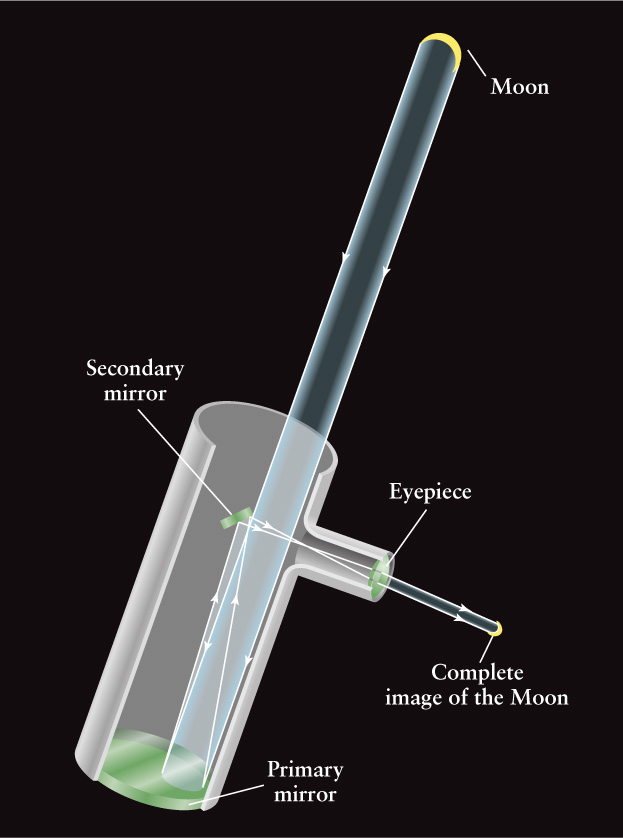
Spherical Aberration
A reflecting telescope must be designed to minimize a defect called spherical aberration (Figure 6-13). At issue is the precise shape of a mirror’s concave surface. A spherical surface is easy to grind and polish, but different parts of a spherical mirror focus light onto slightly different spots (Figure 6-13a). This results in a fuzzy image.
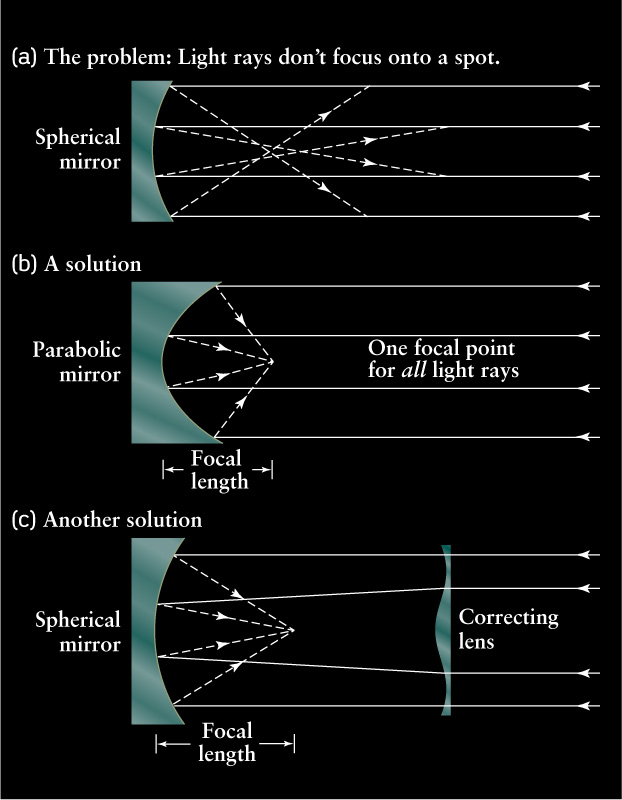
One common way to eliminate spherical aberration is to polish the mirror’s surface to a parabolic shape, because a parabola reflects parallel light rays to a common focus (Figure 6-13b). Unfortunately, the astronomer then no longer has a wide-angle view. Furthermore, unlike spherical mirrors, parabolic mirrors suffer from a defect called coma, wherein star images far from the center of the field of view are elongated to look like tiny teardrops. A different approach is to use a spherical mirror, thus minimizing coma, and to place a thin correcting lens at the front of the telescope to eliminate spherical aberration (Figure 6-13c). This approach is only used on relatively small reflecting telescopes for amateur astronomers.
The Largest Reflectors
There are over a dozen optical reflectors in operation with primary mirrors between 8 meters (26.2 feet) and 11 meters (36.1 feet) in diameter. Figure 6-14a shows the objective mirror of one of the four Very Large Telescope (VLT) units in Chile, and Figure 6-14b shows the objective and secondary mirrors of the Gemini North telescope in Hawaii. A near-twin of Gemini North, called Gemini South, is in Cerro Pachón, Chile. These twins allow astronomers to observe both the northern and southern parts of the celestial sphere with essentially the same state-of-the-art instrument. Two other “twins” are the side-by-side 8.4-m objective mirrors of the Large Binocular Telescope in Arizona. Combining the light from these two mirrors gives double the light-gathering power, equivalent to a single 11.8-m mirror.
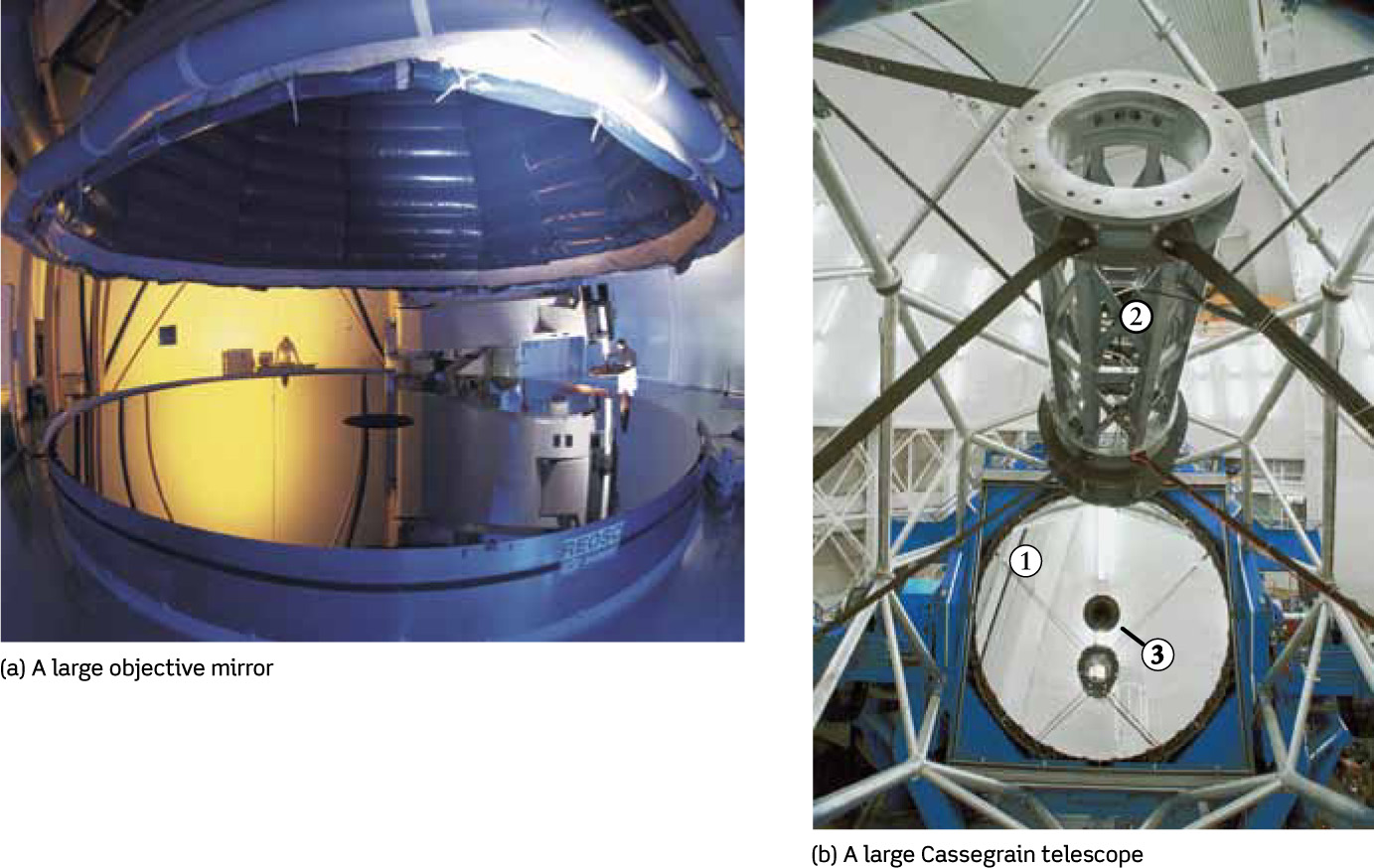
Reflecting Telescopes (a) This photograph shows technicians preparing an objective mirror 8.2 meters in diameter for the European Southern Observatory in Chile. The mirror was ground to a curved shape with a remarkable precision of 8.5 nanometers. (b) This view of the Gemini North telescope shows its 8.1-meter objective mirror (1). Light incident on this mirror is reflected toward the 1.0-meter secondary mirror (2), then through the hole in the objective mirror (3) to the Cassegrain focus (see Figure 6-11b).
Several other reflectors around the world have objective mirrors between 3 and 6 meters in diameter, and dozens of smaller but still powerful telescopes have mirrors in the range of 1 to 3 meters. There are thousands of professional astronomers, each of whom has several ongoing research projects, and thus the demand for all of these telescopes is high. On any night of the year, nearly every research telescope in the world is being used to explore the universe.
CONCEPT CHECK 6-4
Does the angle of light reflected off a mirrored surface depend on wavelength? How does the answer to this question help or hurt a reflecting telescope?
Reflection off a mirror does not depend on wavelength. This is a key advantage for a reflecting telescope, because it prevents the chromatic aberration that blurs images in telescopes made from lenses.